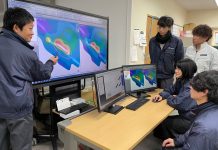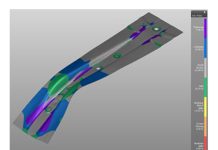In previous posts, we discussed the industry challenge of springback. Everybody wants a springback “silver bullet” or easy solution for Springback Compensation—alternative geometry in the tooling, which allows the stamped part to have the desired shape after elastic deformation recovery. The most common method of springback compensation is the overbend/overcrown method. If you observe a sheet metal part with springback, merely deform it an equivalent amount in the opposite direction of the springback and voila, compensation. While this is sensible for some modes of springback, it is not universal. In fact, some springback phenomena cannot be compensated.

Springback of this outer hood shows significant overcrown at the windshield-cowl line.
Stretch Flanges
Flanges where the curvature of the flange line creates a need to stretch material in the free edge of the flange are often called stretch flanges. The stretching in the free edge is caused by the difference in the developed trim line stretching to form the larger radius of the finished flange. The material in the flange edge will stretch as it is being formed. As with all conventionally stamped sheet metals, the stretching deformation during the forming process is a combination of plastic and elastic strain. When the forming is complete and the tool opens, elastic strains spring back toward the sheet’s initial shape.

Stretch flange: before, during, after. Springback in flange distorts the adjacent surface
Because of the radial stretching mode in the forming of the flange, the springback behavior is a radial shrinking of the material. This shrinking pulls the ends of the flange toward one another and in doing so makes the adjacent surface “overcrown.”

Tensile forming conditions lead to a shrinking in the flange edge; adjacent surface springs upward
If the process/method planning engineer were to utilize a conventional springback compensation technique, they would likely create, in the initial forming tool, shape in the opposite direction of the observed springback—forming the surface an equal amount downward as compensation for the springback distortion. The logic behind that type of compensation is that the material will move in a similar direction and magnitude as the original observed springback, the hope being that an undercrown during forming and the overcrown due to springback might effectively cancel each other out. This would not resolve the springback deviation. It is more likely that compensation applied to the surface adjacent to the flange could display even greater springback distortion, as the observed distortion is not due to springback in the large flat surface, but in the flange itself.
One countermeasure often employed by toolmakers is to change the flanging entry height to intentionally create a compressive forming along the stretch flange. By locally affecting the deformation mode during flanging, the springback mechanism that leads to the overcrown is mitigated.

Flange steel contacts metal from outside-in, which compresses the material toward the center of flange instead of stretching
Once a process/method engineer sees that a proposed solution has the potential to correct the issue, they need only find the precise adjustment that corrects the behavior to their satisfaction and produces repeatable and reliable results. If they use a Systematic Process Improvement methodology, they should be able to identify the process change that produces the most repeatable results with the least amount of trial and error.














[…] “Springback Compensation: When not to try” highlights situations where springback compensation is not recommended. “Virtual Tryout and Process Engineering” challenges the industry goal of obtaining perfection in virtual tryout, noting that tryout, virtual or in press, is just the simulation of a hypothetical set of process inputs. We introduce the concept of Systematic Process Improvement as a method to arrive at a passing simulation with less trial and error, and how robust engineering can significantly improve the chances that the engineered tool performs as expected in production. “Have You Been Burned by Minimum Blank Quotes?” notes that blank predictions for crash form, progressive, and draw die forming tools are potentially very different and require some additional consideration prior to quoting based on your results. […]
[…] the challenges with compensating springback several times within this blog (1 link, another link, and one more link) . In those earlier posts, we mentioned that the mode of the springback along […]